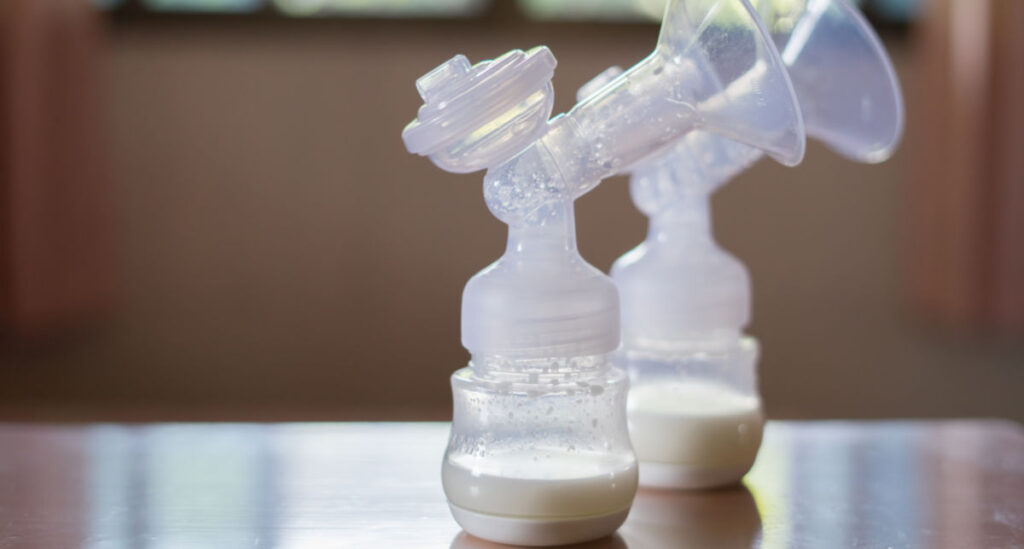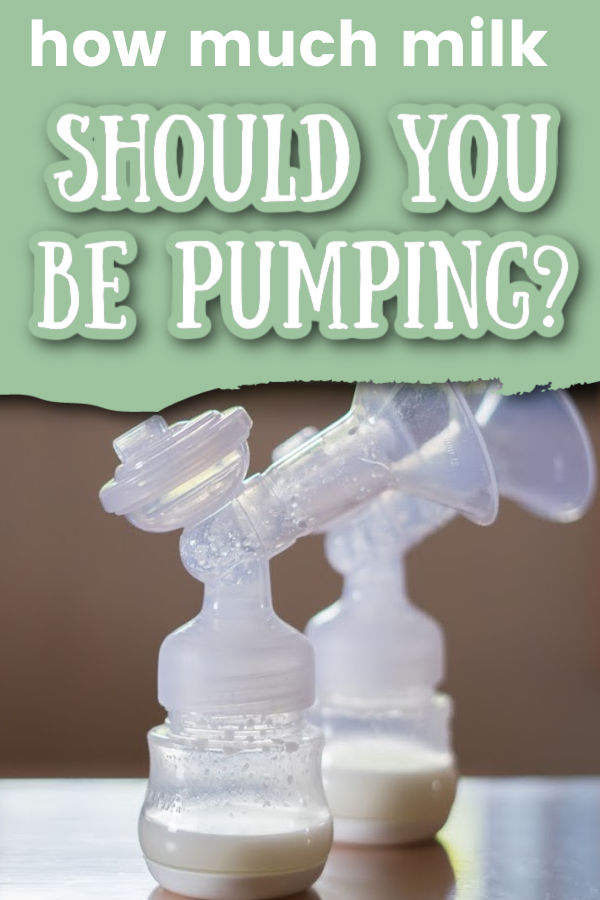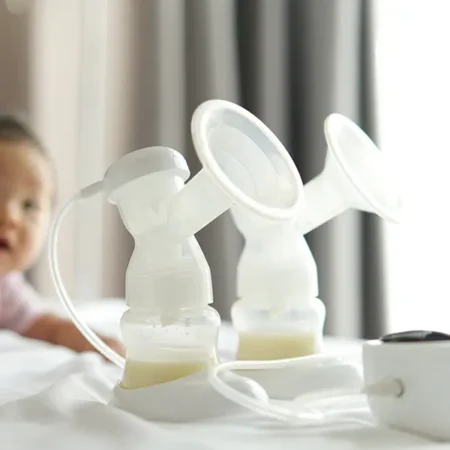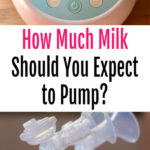Are you wondering how much milk you should be pumping? Here’s what influences the amount you pump, what is a typical quantity to pump, and how to know how much you should aim for.

This post may contain affiliate links, which means if you click a link and purchase something, I may make a small commission at no additional cost to you. I only recommend products I love! More information here.
“How much milk should I be pumping?”
I do a weekly Q&A on instagram, and this question almost always gets asked. I understand why people ask it, but I really struggle with it. I know you want a clear answer, something like: you should be pumping 3oz in each pumping session.
But this simple answer doesn’t exist.
Milk supply has a wide range of normal and depends on a few variables (we’ll talk more about these in a minute).
I’ll try to explain using an example.

- Ann’s baby, Amelia, takes about 25oz of milk per day. Ann pumps eight times a day, getting about 30oz per day.
- Bella’s baby, Beatrice, eats 35oz of milk per day. Bella pumps about 5oz, six times per day, for a total of 30oz per day.
Both of these are normal amounts for a baby to take and for a mom to pump. But one mom is an oversupplier, and the other is an undersupplier.
So what you want to focus on is NOT an arbitrary number, like 3oz each pumping session, but rather how much you are pumping relative to what your baby needs. Ideally, you want to pump about as much as your baby takes, plus a little extra cushion.
I know that you probably still just want some numbers. I’ll give you some typical amounts, but first, let’s go through four things that will impact how much you pump.
The amount of breast milk you pump depends on these things
Many women are concerned that their milk supply might be low if they don’t pump as much as they’d like. However, there are other factors that can come into play.
1. Are you pumping after nursing, or just pumping?
If you are pumping after nursing your baby (to build a freezer stash, or to increase your milk supply), then you should expect to pump LESS than you would if you are exclusively pumping or if you are replacing a nursing session with a pumping session.
Because your baby will already have removed some or most of the milk you have in your breasts, there will be less milk available for you to pump.
Don’t compare the amount that you pump after nursing to the amount someone who didn’t nurse beforehand pumped.
2. How your body responds to the pump
You might have heard that a breast pump will never be as effective as a baby at removing milk, so you shouldn’t judge your milk supply by the amount you pump.
While I don’t think this is true for ALL women – I had a bigger supply with the baby I exclusively pumped for than the two that I nursed – it is definitely true for some.
Some women do not seem to respond well to a breast pump – they have hard time getting their milk to letdown, and the pump doesn’t remove milk as well.
These women will tend to PUMP less milk than they HAVE, because their breast pump isn’t effective in getting it out.
(If this is an issue for you, I suggest trying hand expression or a manual pump and see if that works better for you. Also, I would see if any of these strategies for getting a letdown are helpful.)
3. Age of your baby
The age of your baby/how many weeks you are postpartum can play a role in how much milk you pump as well.
Breast milk production timeframes
Here are some timeframes regarding breast milk production to keep in mind:
- Immediately after birth, your body will produce colostrum until your milk comes in. Colostrum can be sometimes be difficult to pump because of its thickness; also, because babies don’t need very much colostrum, your breasts produce comparatively little.
- After 2-5 days, your milk should come in, and you’ll produce more breast milk.
- After about one month of age, the total amount of breast milk that babies take in tends to stabilize and stay the about the same until they start solids (excluding growth spurts).
- Sometime in the first 12 weeks of breastfeeding (usually somewhere between 3-12 weeks postpartum), your milk supply will regulate. This means that your supply is more influenced by the demand (from your baby or your breast pump) than by your hormones. More on this here.
How this affects the amount you pump
What does this mean for how much you should expect to pump?
- You should expect to pump relatively little until your milk comes in
- The amount you pump in the weeks after your milk comes in may change as your milk supply regulates (and, if you are nursing, as your baby begins to take more milk)
- After 1-3 months, the amount you pump should level out and stabilize
Need help with exclusive pumping? Use EPUMP30 for 30% off
4. Your milk supply
Finally, and obviously, the amount of milk that you are producing will also affect the amount that you might pump.
If you’re struggling with milk supply, here are some strategies that might help.
Just give me the numbers
Most babies take somewhere between 20-40 oz of breast milk per day, which is also typical breast milk production. (Though some moms make more and some make less, and both are normal.)
How much you might expect to get in a pumping session would be that range divided by the number of times you’re feeding and pumping per day.
So say you exclusively pump, and you pump 10 times per day. You might expect to get 2-4oz each time.
Note that this is a rough estimate, and also that the amounts you get over the course of a day will not be consistent. You might get 5oz in your first session of the day, 4oz in the second, and then 2-3oz for the rest of the day.
This gets even messier as a way to estimate when you consider nursing. For example, if your baby just nursed and you pump right afterwards, you probably won’t get a full feeding, or 2-4oz. In this scenario, you might get closer to 1/4-1/2 of a feeding, or 1-2 oz.
Hopefully, this gives you a general idea, even if a lot depends on your personal situation.
Finally, I just wanted to say – it doesn’t matter how much other people are pumping or what the experts say you “should” pump. You are doing the best you can, and you are doing a great job.
Let me know if you have any questions about how much milk you should be pumping in the comments!
Stressed about establishing or increasing your milk supply while exclusively pumping? Always worried there is something else you should be trying? Check out my milk supply guide here (use code SUPPLY for 10% off)!

References
- Bonyata, Kelly. “Growth sprurts.” https://kellymom.com/hot-topics/growth-spurts/




















